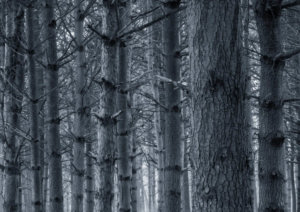The benefits of diversity

I often talk about encouraging diversity in our forests. The reaction of most people is that they want their forest to be diverse, but they might not know what that actually means or why it’s important.
In an ecological context, diversity means several different things. The term is usually used to describe species diversity, the number of different species of trees in a forest. In this sense, a forest with a lot of different species of trees is very diverse.
A lesser-known type of diversity is structural diversity, which I think of as the way that the forest is growing. Structural diversity can be defined as the arrangement of different ages and sizes of trees in a forest; a forest with patches of young trees, old trees and middle-aged trees—and all ages and sizes of trees growing together—is structurally diverse.
Structural diversity can also refer to the presence of different types of dead trees—dead-standing trees (snags) and dead wood on the forest floor of all different shapes and sizes. While it may seem counter-intuitive, dead wood in the forest is incredibly important (arguably as important as living trees) for a ton of different ecological functions. These range from providing habitat for everything from birds and mammals to the tiny bugs and fungi that make our forests work, to influencing forest hydrology and forming rich soils for future generations of trees.
Readers of this column know that I advocate for both species diversity and structural diversity constantly. I do this because diversity supports everything that we want to manage forests for. Diverse forests store more carbon, and we expect them to be better suited to a changing climate. They provide habitat for a wide range of Vermont’s wildlife. Studying old growth forests also shows us that species and structural diversity are important parts of how forests naturally grow and develop, which we want to emulate in any management that we do.
Think about the importance of diversity as a forest having more tools in its toolkit. Forests with a lot of species and structural diversity are more resilient—able to remain healthy and productive amidst great stress and change—and adaptive—able to respond differently to the varied forms that disturbance and stressors take. Diversity protects forests from stressors that target a single species of tree—like the emerald ash borer—or a single size of tree—like a windstorm that wipes out a forest’s overstory but leaves the understory intact. These qualities are important to any forest, but are especially crucial in a changing climate, when we expect natural disturbances to increase in intensity and frequency and for climatic changes to impact different tree species differently.
We want to cultivate diversity both within our forests and across the landscape. When managing for diverse forests, most people encourage Alpha diversity, the sheer number of different species and conditions in their forest. Looking solely at Alpha diversity, edges—where forests meet non-forested areas—are some of our most diverse habitats, used by huge numbers of tree, plant and animal species.
If you managed a forest for maximum Alpha diversity by creating a ton of edges, you would help some wildlife species but neglect those that need something different, like wildlife that require large, unbroken forest blocks. You might create great foraging habitat for a species, but nowhere for them to breed, nest, or rear their young. You would also be encouraging a habitat type that we already have in abundance—as our landscape becomes more developed and fragmented, there are plenty of edges and comparatively little unbroken interior forest. For these reasons, in addition to Alpha diversity you should consider Beta Diversity—the uniqueness of a site. While a forest or habitat may not support a lot of different species, it might provide something unique—a critical habitat for a few species—and so be worth protecting.
When species diversity, structural diversity, Alpha diversity and Beta diversity combine, they form complex, resilient and ecologically functional landscapes. These are landscapes that are beautiful— supporting our quality of life and the character of our communities, functional—providing clean air, clean water, and many other benefits that make our world work, and productive—producing local renewable resources and other economic and cultural opportunities like forest-based recreation—into the indefinite future.
Ethan Tapper is the Chittenden County Forester for the Vermont Department of Forests, Parks and Recreation. He can be reached at his office at 111 West Street, Essex Junction, at (802) 585-9099, or via email.

